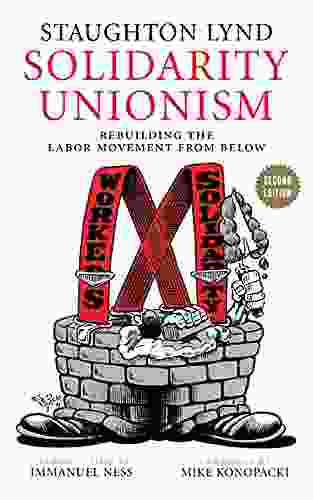Solidarity Unionism: Rebuilding the Labor Movement From Below

5 out of 5
| Language | : | English |
| File size | : | 3312 KB |
| Text-to-Speech | : | Enabled |
| Screen Reader | : | Supported |
| Enhanced typesetting | : | Enabled |
| Word Wise | : | Enabled |
| Print length | : | 86 pages |
The labor movement in the United States is at a crossroads. Union membership has been declining for decades, and unions have been weakened by corporate attacks and government policies. As a result, workers have lost ground in wages, benefits, and working conditions.
Solidarity unionism is a strategy for rebuilding the labor movement from below. It seeks to build strong, democratic unions that are capable of fighting for the needs of workers in the 21st century. This article will explore the history, principles, and practices of solidarity unionism, and argue that it is a viable and necessary strategy for the future of labor.
The History of Solidarity Unionism
The roots of solidarity unionism can be traced back to the early days of the labor movement. In the late 19th and early 20th centuries, workers in the United States organized into unions to fight for better wages, hours, and working conditions. These unions were often led by socialists and other radicals who believed that workers needed to unite across racial, ethnic, and gender lines to fight for their common interests.
In the mid-20th century, solidarity unionism was eclipsed by a more conservative model of unionism that focused on negotiating contracts with employers and providing benefits to members. This model of unionism was successful in raising wages and benefits for many workers, but it also led to a decline in union membership and power.
In the late 20th and early 21st centuries, there has been a resurgence of interest in solidarity unionism. This is due in part to the decline of the traditional model of unionism, as well as the growing inequality and insecurity that workers face in the 21st century economy.
The Principles of Solidarity Unionism
Solidarity unionism is based on the following principles:
- Worker solidarity: Solidarity unionism believes that workers have common interests that transcend racial, ethnic, gender, and other divisions. Workers must unite across these divisions to fight for their common interests.
- Democracy: Solidarity unions are democratic organizations that are controlled by their members. Members have a say in all decisions, from the election of leaders to the setting of union policy.
- Militancy: Solidarity unions are willing to use militant tactics, such as strikes and protests, to fight for their goals. They believe that workers have the right to fight for what they deserve, and that they should not be afraid to use their power to achieve their goals.
The Practices of Solidarity Unionism
Solidarity unionism is practiced in a variety of ways. Some of the most common practices include:
- Organizing: Solidarity unions focus on organizing workers into unions. They believe that the best way to improve the lives of workers is to organize them into unions that can bargain for better wages, benefits, and working conditions.
- Bargaining: Solidarity unions bargain with employers to improve the wages, benefits, and working conditions of their members. They are willing to use militant tactics, such as strikes and protests, to win their demands.
- Solidarity actions: Solidarity unions support each other's strikes and protests. They believe that workers have a common interest in fighting for better working conditions, and that they should support each other in their struggles.
The Benefits of Solidarity Unionism
Solidarity unionism offers a number of benefits for workers. These benefits include:
- Higher wages and benefits: Solidarity unions have been shown to raise wages and benefits for their members. This is because solidarity unions are able to bargain more effectively with employers, and they are willing to use militant tactics to win their demands.
- Improved working conditions: Solidarity unions have also been shown to improve the working conditions of their members. This is because solidarity unions are able to bargain for better working conditions, and they are willing to use militant tactics to enforce these conditions.
- Increased worker power: Solidarity unions give workers a greater voice in the workplace. This is because solidarity unions are controlled by their members, and members have a say in all decisions. This gives workers a sense of empowerment, and it allows them to have a greater say in their working lives.
The Challenges of Solidarity Unionism
Solidarity unionism also faces a number of challenges. These challenges include:
- Employer opposition: Employers are often opposed to solidarity unionism. This is because solidarity unions pose a threat to employer power. Employers may use a variety of tactics to oppose solidarity unions, such as union busting and blacklisting.
- Government repression: Governments may also repress solidarity unions. This is because solidarity unions can challenge the authority of the state. Governments may use a variety of tactics to repress solidarity unions, such as arrests, violence, and imprisonment.
- Internal divisions: Solidarity unions can also be divided by internal divisions. These divisions may be based on race, ethnicity, gender, or other factors. Internal divisions can weaken solidarity unions and make it difficult for them to fight for their goals.
The Future of Solidarity Unionism
Despite the challenges, solidarity unionism remains a viable and necessary strategy for rebuilding the labor movement from below. Solidarity unions offer workers a way to fight for better wages, benefits, and working conditions. They also give workers a greater voice in the workplace and help to build worker power.
The future of labor depends on the ability of workers to organize and fight for their rights. Solidarity unionism offers a path to a more just and equitable future for workers.
"Solidarity unionism is the only way that workers can fight for their rights and improve their lives. It is a powerful force that can change the world."
Dolores Huerta, labor leader
5 out of 5
| Language | : | English |
| File size | : | 3312 KB |
| Text-to-Speech | : | Enabled |
| Screen Reader | : | Supported |
| Enhanced typesetting | : | Enabled |
| Word Wise | : | Enabled |
| Print length | : | 86 pages |
Do you want to contribute by writing guest posts on this blog?
Please contact us and send us a resume of previous articles that you have written.
 Book
Book Novel
Novel Page
Page Chapter
Chapter Story
Story Library
Library E-book
E-book Magazine
Magazine Sentence
Sentence Bookmark
Bookmark Shelf
Shelf Glossary
Glossary Bibliography
Bibliography Synopsis
Synopsis Annotation
Annotation Footnote
Footnote Scroll
Scroll Codex
Codex Classics
Classics Autobiography
Autobiography Memoir
Memoir Encyclopedia
Encyclopedia Dictionary
Dictionary Resolution
Resolution Librarian
Librarian Catalog
Catalog Card Catalog
Card Catalog Archives
Archives Lending
Lending Academic
Academic Reading Room
Reading Room Rare Books
Rare Books Special Collections
Special Collections Interlibrary
Interlibrary Literacy
Literacy Thesis
Thesis Awards
Awards Book Club
Book Club Theory
Theory Textbooks
Textbooks Jasmine Guillory
Jasmine Guillory Sharon Cassanolochman
Sharon Cassanolochman J R Erickson
J R Erickson Cute Broidery Company
Cute Broidery Company Carrie Stuart Parks
Carrie Stuart Parks Bob Stewart
Bob Stewart D Brooklyn
D Brooklyn Gavin Baddeley
Gavin Baddeley Barbara Mcclintock
Barbara Mcclintock Ellen D Wu
Ellen D Wu C A Gray
C A Gray Janine Joseph
Janine Joseph Linda Evans Shepherd
Linda Evans Shepherd Renee Rominger
Renee Rominger T J Mitchell
T J Mitchell Casey Watson
Casey Watson Mariusz Wilk
Mariusz Wilk Issiah B Burckhardt
Issiah B Burckhardt Barton Press
Barton Press Robert Bailey
Robert Bailey
Light bulbAdvertise smarter! Our strategic ad space ensures maximum exposure. Reserve your spot today!

 Vincent MitchellOwl Counted Cross Stitch Patterns: A Journey into Intricate Stitched Delights
Vincent MitchellOwl Counted Cross Stitch Patterns: A Journey into Intricate Stitched Delights Foster HayesFollow ·2.4k
Foster HayesFollow ·2.4k Blake KennedyFollow ·19.8k
Blake KennedyFollow ·19.8k Israel BellFollow ·17.5k
Israel BellFollow ·17.5k Hugo CoxFollow ·10.6k
Hugo CoxFollow ·10.6k Jay SimmonsFollow ·8.1k
Jay SimmonsFollow ·8.1k Samuel Taylor ColeridgeFollow ·3k
Samuel Taylor ColeridgeFollow ·3k Jerry WardFollow ·8.8k
Jerry WardFollow ·8.8k Darrell PowellFollow ·18.4k
Darrell PowellFollow ·18.4k

 Ralph Ellison
Ralph EllisonHealth Care Global Viewpoints: Samantha Whiskey
Samantha Whiskey is a global health...

 Gabriel Garcia Marquez
Gabriel Garcia MarquezTeacher Educators' Reflections on Culturally Relevant...
In today's...

 Levi Powell
Levi PowellSustainable Project Management: The GPM Reference Guide...
In today's rapidly changing world,...

 Isaac Bell
Isaac BellThe Captivating World of "Dreaming Awake Falling Under"
A Journey Through...

 Clarence Brooks
Clarence BrooksGovernance Regulations Valuations Mergers And...
In today's complex and ever-changing...
5 out of 5
| Language | : | English |
| File size | : | 3312 KB |
| Text-to-Speech | : | Enabled |
| Screen Reader | : | Supported |
| Enhanced typesetting | : | Enabled |
| Word Wise | : | Enabled |
| Print length | : | 86 pages |












